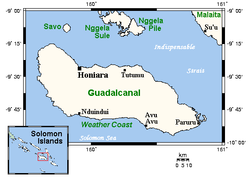History
The only known specimen of Guadacanal rat was described in 1904 by Oldfield Thomas, although it was most likely collected at or around the same time as similar species Uromys rex and Uromus imperator in the late 1880s. The species was registered in 1889 and was collected by Charles Morris Woodford at Aola village in the Solomon Islands. [4]
The species has not been seen since this collection and there is no local knowledge of the species, indicating it is most likely extinct. [1]
Genus Name
When it was first named in 1904 by Oldfield Thomas, the Guadacanal rat was described as a species of Uromys. Later, it was transferred to Melomys, [3] before being placed once again in Uromys, [5] once more in Melomys, [5] until it was returned to Uromys where it is currently placed. [6] [7]
This page is based on this
Wikipedia article Text is available under the
CC BY-SA 4.0 license; additional terms may apply.
Images, videos and audio are available under their respective licenses.

